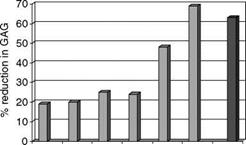KTTKS is a fragment of dermal collagen and has been shown to stimulate production of collagen and thus has been discussed in regard to wound healing (41). Incorporation of long-chain lipophilic residues such as palmitoyl onto peptides can dramatically improve their delivery into skin, e. g., the observed five – to six-fold increase in delivery of palmitoyl peptides versus their underivatized versions (42). Thus, pal-KTTKS was synthesized specifically for topical use of this peptide. Like the underivatized peptide, the palmitate derivative (pal-KTTKS) is also active in stimulating collagen production (43-45). In addition, at extremely low levels (ppb) in culture, pal-KTTKS reduces excess dermal GAGs (Fig. 10). As discussed above, this effect may also contribute to an antiwrinkle effect.
Like KTTKS, GHK is also a fragment of dermal collagen (46). Copper is a required factor for activity of lysyl oxidase, an enzyme involved in collagen synthesis (47). The complex of these two (Cu-GHK) has been shown to stimulate wound healing processes
|
|
|
|
|
|
|

in laboratory model systems by increasing production of dermal matrix components such as collagen and specific matrix remodeling matrix metalloproteinases (MMPs) (48-52).
Ac-EEMQRR is described as a mimic of botulinum neurotoxin (Botox®) which functions by inhibiting neurotransmitter release, thus “relaxing” the muscles involved in defining facial wrinkles (53).
Since the reported mechanisms of pal-KTTKS and Cu-GHK involve matrix production and remodeling, their appearance benefits would be expected to require chronic treatment. In contrast, Ac-EEMQRR should have acute benefit effects based on its reported Botox®-like mechanism.
